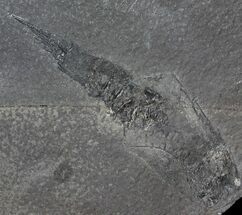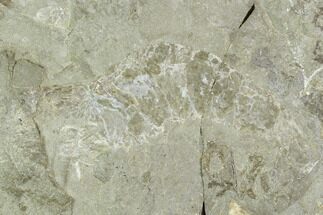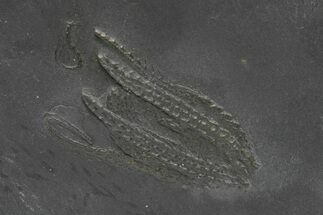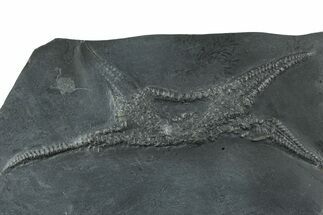This Specimen has been sold.
2.8" Devonian Phyllocarid Fossil - Bundenbach, Germany
This is an unusual phyllocarid (Nahecaris sp.?) from the Hunsrück Slate of Germany. It's 2.8" long and rests on a 12.7 x 7.3" rectangular piece of slate.
It comes with an acrylic display stand.
It comes with an acrylic display stand.
About Phyllocarids
Phyllocarids are an extinct group of marine arthropods that thrived from the Cambrian to the Devonian period, with some surviving into the Carboniferous. They belong to the subclass Phyllocarida within the class Malacostraca, which includes modern crustaceans like lobsters, shrimp, and crabs. Phyllocarids are characterized by their unique body structure, which includes a bivalve-like carapace that covered the head and thorax, giving them a shrimp-like appearance. This carapace is often smooth but can exhibit ridges or spines, depending on the species.
Their segmented abdomen extends beyond the carapace, ending in a fan-like tail structure called a telson, which is flanked by smaller appendages known as uropods. The carapace helped protect their front limbs, which they used for feeding, while their back limbs were likely adapted for swimming and maneuvering in the water. They are thought to have been filter feeders, scraping detritus or small particles of food from the water column.
Fossils of phyllocarids are relatively rare, but they provide valuable insights into the evolution of crustaceans and other arthropods. Their remains are often found in marine sediments, especially in locations where fine-grained rock has preserved their delicate structures.
Phyllocarids are an extinct group of marine arthropods that thrived from the Cambrian to the Devonian period, with some surviving into the Carboniferous. They belong to the subclass Phyllocarida within the class Malacostraca, which includes modern crustaceans like lobsters, shrimp, and crabs. Phyllocarids are characterized by their unique body structure, which includes a bivalve-like carapace that covered the head and thorax, giving them a shrimp-like appearance. This carapace is often smooth but can exhibit ridges or spines, depending on the species.
Their segmented abdomen extends beyond the carapace, ending in a fan-like tail structure called a telson, which is flanked by smaller appendages known as uropods. The carapace helped protect their front limbs, which they used for feeding, while their back limbs were likely adapted for swimming and maneuvering in the water. They are thought to have been filter feeders, scraping detritus or small particles of food from the water column.
Fossils of phyllocarids are relatively rare, but they provide valuable insights into the evolution of crustaceans and other arthropods. Their remains are often found in marine sediments, especially in locations where fine-grained rock has preserved their delicate structures.
Most of the Bundenbach quarries have been closed for some time, so a very limited amount of material is coming to market from this area.
The lower Devonian (lower Emsian) slates from Bundenback have been quarried for roofing material for centuries. Quarrying continued until the 1960s, when the competition from cheaper synthetic or imported slate resulted in production decline. The last pit closed in 2000. Mining of Hunsrück slate was important for the discovery of Paleozoic fossils. Although not rare, fossils can only be found through extensive mining and time-consuming preparation: fossils are hard to see lying under the surface of dark slate. But in 1970, Wilhelm Stürmer, a chemical physicist and radiologist, developed a new method to examine the Hunsrück slate fossils using medium energy X-rays.
The Bundenbach “Hunsruck Slate" is famous for yielding one of the most important assemblages of Paleozoic fossils, representing 260 animal species including mollusks, echinoderms and arthropods, of which the phacopid trilobite Chotecops is certainly the most abundant.
The lower Devonian (lower Emsian) slates from Bundenback have been quarried for roofing material for centuries. Quarrying continued until the 1960s, when the competition from cheaper synthetic or imported slate resulted in production decline. The last pit closed in 2000. Mining of Hunsrück slate was important for the discovery of Paleozoic fossils. Although not rare, fossils can only be found through extensive mining and time-consuming preparation: fossils are hard to see lying under the surface of dark slate. But in 1970, Wilhelm Stürmer, a chemical physicist and radiologist, developed a new method to examine the Hunsrück slate fossils using medium energy X-rays.
The Bundenbach “Hunsruck Slate" is famous for yielding one of the most important assemblages of Paleozoic fossils, representing 260 animal species including mollusks, echinoderms and arthropods, of which the phacopid trilobite Chotecops is certainly the most abundant.
SPECIES
Nahecaris sp.?
LOCATION
Bundenbach, Germany
FORMATION
Hunsrück Slate
SIZE
Phyllocarid: 2.8" long, Slate: 12.7 x 7.3"
CATEGORY
ITEM
#209941
We guarantee the authenticity of all of our specimens.
 Reviews
Reviews











